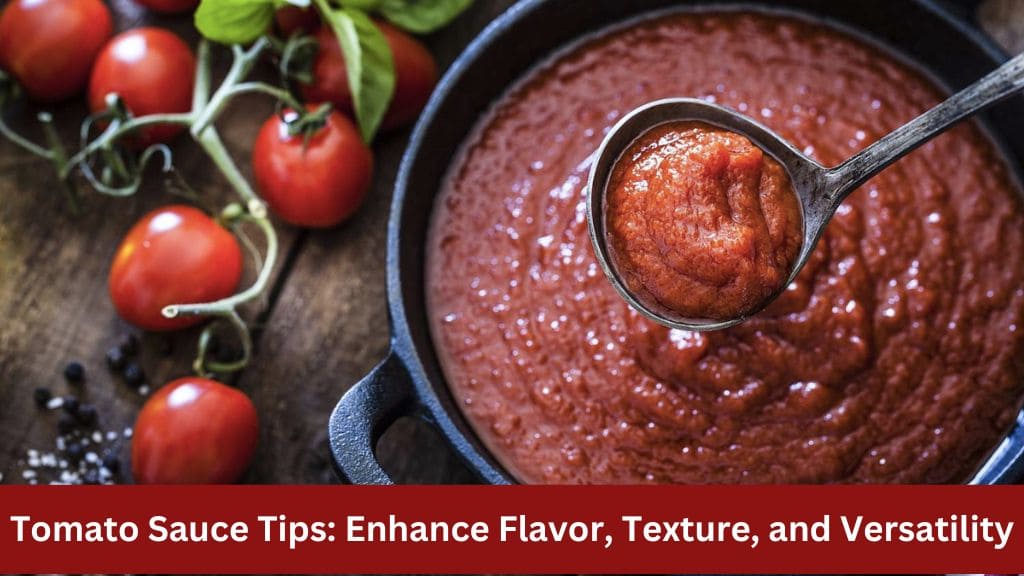Tomato sauce is a staple in many kitchens around the world, beloved for its versatility and rich, comforting flavor. Whether you’re using it as a base for pasta dishes, a topping for pizza, or a complement to meats and vegetables, mastering the art of tomato sauce can significantly enhance your culinary repertoire. In this blog post, we’ll delve into expert tips and techniques to help you create the most flavorful and textured tomato sauce imaginable. We’ll cover everything from ingredient selection and cooking methods to advanced flavor enhancement techniques.

Tomato sauce is one of the five Mother Sauces in classical French cuisine, forming the base for many dishes. It’s celebrated for its depth of flavor and adaptability. Unlike some other Mother Sauces, tomato sauce is commonly made at home, and even store-bought versions can be quite tasty. However, homemade tomato sauce offers the opportunity to customize and elevate the flavor and texture to your preference.
Ingredient Selection
:max_bytes(150000):strip_icc()/Simply-Recipes-Homemade-Tomato-Sauce-LEAD-SEO-fb1550f16f474d6e90d04a66d0736631.jpg)
Choosing the Right Tomatoes
The foundation of any great tomato sauce is, unsurprisingly, the tomatoes. The quality and type of tomatoes you choose can drastically affect the outcome of your sauce.
- Fresh Tomatoes: If using fresh tomatoes, select ripe, high-quality varieties such as Roma, San Marzano, or Beefsteak. These types are known for their meatiness and rich flavor.
- Canned Tomatoes: Canned tomatoes are a convenient and reliable choice, often picked and processed at peak ripeness. Look for whole canned tomatoes or crushed tomatoes from reputable brands.
Other Essential Ingredients
While tomatoes are the star, several other ingredients play crucial roles in creating a balanced and flavorful sauce.
- Aromatics: Onions, garlic, and shallots are essential for building the base flavor.
- Herbs and Spices: Fresh or dried basil, oregano, parsley, and bay leaves add depth and complexity.
- Sweeteners: A touch of sugar or naturally sweet ingredients like carrots can balance acidity.
- Acidic Components: Wine, vinegar, or citrus juice enhance brightness and complexity.
- Umami Enhancers: Ingredients like Parmesan rinds, anchovy paste, or mushrooms can deepen the umami profile.
Flavor Development
:max_bytes(150000):strip_icc()/the-best-slow-cooked-italian-american-tomato-sauce-red-sauce-recipe-step-09-05ad7578f9d34a5092086ae959bea8a7.jpg)
Developing a rich and complex flavor profile is the key to a standout tomato sauce. This involves balancing sweetness, acidity, and umami.
Balancing Sweetness
Tomatoes naturally contain sweetness, but sometimes they need a little help, especially if they are out of season or not fully ripe.
- Cooking Tomatoes: Cooking helps to concentrate and enhance the natural sugars in tomatoes.
- Adding Sugar: A small amount of sugar can balance the acidity without making the sauce overtly sweet. Add incrementally and taste as you go.
- Using Sweet Vegetables: Carrots, bell peppers, or even a bit of roasted squash can add a subtle sweetness. Grate or finely chop and sauté these vegetables with your aromatics.
Enhancing Acidity
Acidity is crucial for a vibrant and balanced tomato sauce. It brightens the flavors and adds a refreshing note.
- Wine: Dry white wine is a classic addition. It adds acidity and depth. Cook off the alcohol by simmering for a few minutes before adding other ingredients.
- Vinegar: A splash of high-quality vinegar, such as red wine vinegar or balsamic vinegar, can add complexity. Use sparingly and allow it to cook off.
- Citrus: Fresh lemon juice added towards the end of cooking can brighten the sauce without overpowering it.
Boosting Umami
Umami is the savory flavor that adds depth and satisfaction to your sauce.
- Meat: Browning meat or bones in the sauce base adds rich, savory flavors.
- Anchovy Paste: Just a small amount can significantly enhance the umami without making the sauce taste fishy.
- Parmesan Rinds: Adding a Parmesan rind during simmering enriches the sauce with a subtle, cheesy umami.
- Mushrooms: Sautéed mushrooms or a bit of mushroom powder can deepen the umami, making it a great vegetarian option.
Techniques for Texture
The texture of your tomato sauce can vary from chunky to smooth, each with its own uses and appeal. Here, we’ll explore three popular styles.
Concasse-Style Tomato Sauce
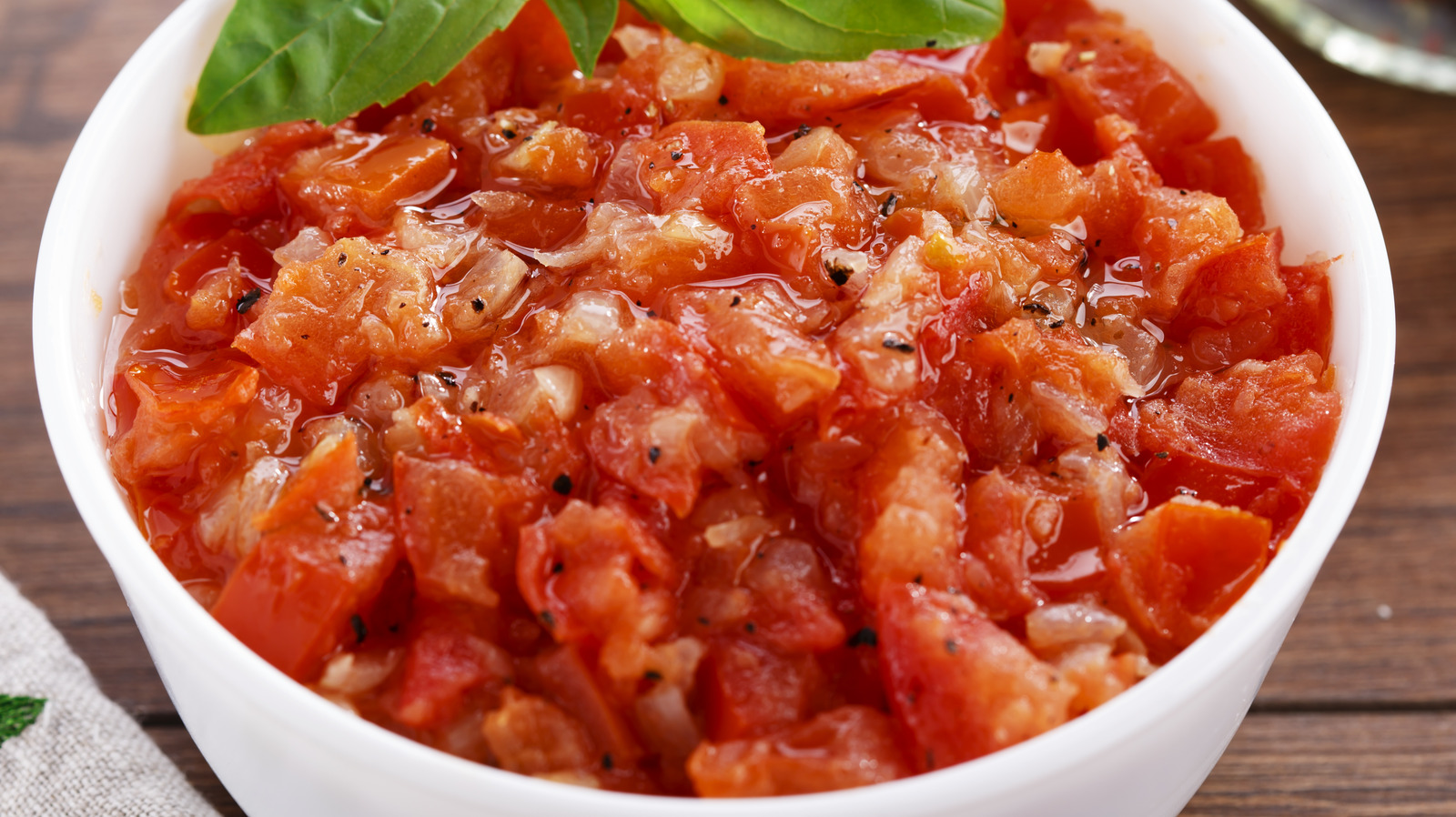
Concasse refers to tomatoes that have been peeled, seeded, and diced. This style is characterized by small chunks of tomato in a light sauce, ideal for lighter dishes.
Ingredients:
- 2 ounces olive oil
- 1-2 garlic cloves, minced
- 1 shallot, minced
- 2.5 pounds beefsteak or heirloom tomatoes, peeled, seeded, and diced
- 1/2 cup dry white wine
- Salt and pepper to taste
- Sugar to taste (optional)
- Fresh herbs (parsley, basil, tarragon, chervil, or dill)
Instructions:
- Heat olive oil over low to moderate heat. Sauté garlic and shallots until fragrant.
- Add tomatoes and white wine. Simmer for 5-20 minutes to reduce and concentrate flavors.
- Season with salt, pepper, and a pinch of sugar if needed. Stir in fresh herbs before serving.
Coulis-Style Tomato Sauce
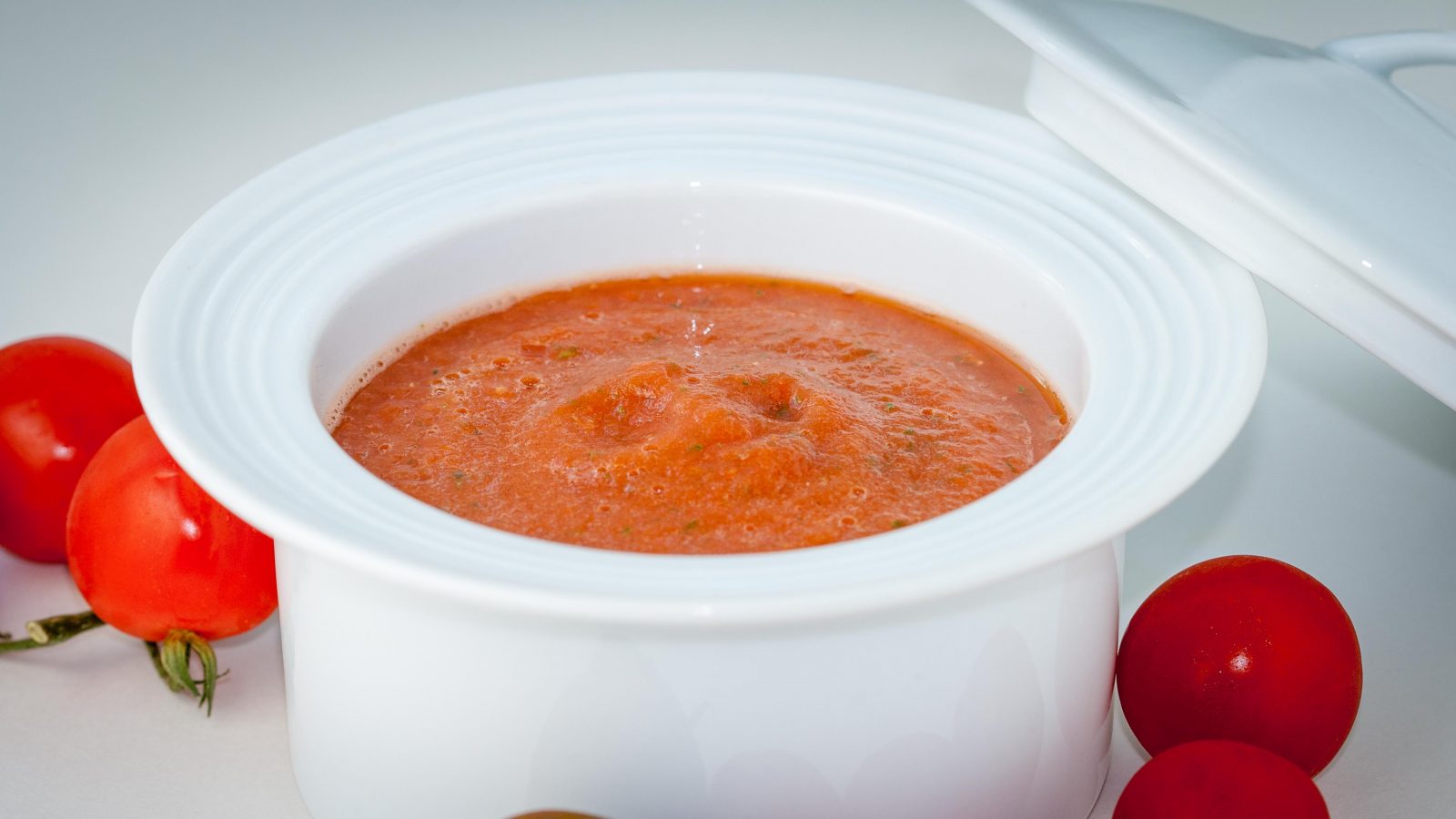
Coulis is a smooth, velvety sauce, often used to enrich dishes with a delicate, buttery tomato flavor.
Ingredients:
- 2 tablespoons olive oil
- 2 tablespoons butter
- 2 garlic cloves, minced
- 1 shallot, minced
- 2 pounds Roma tomatoes, peeled, seeded, and diced
- 1/3 cup dry white wine
- Salt and sugar to taste
- Fresh herbs (parsley, basil, tarragon, chervil, or oregano)
Instructions:
- Heat olive oil and butter over low to moderate heat. Sauté garlic and shallots until fragrant.
- Add tomatoes and white wine. Simmer for 10-30 minutes.
- Puree the mixture in a blender until smooth. Season with salt, sugar, and fresh herbs.
Classic Tomato Sauce

This is the robust, thick tomato sauce often used for pasta dishes, lasagna, and hearty meat dishes.
Ingredients:
- 1-2 tablespoons olive oil
- 1-2 tablespoons butter
- 1/2 to 1 pound pork neck bones, Italian sausage, or ground beef
- 1 medium onion, diced
- 1 large carrot, diced
- 2-3 garlic cloves, minced
- 2 tablespoons fresh oregano, minced
- 2 28-ounce cans whole canned tomatoes
- 3 bay leaves
- Salt to taste
Instructions:
- Heat a stock pot over medium-high heat. Add olive oil and butter.
- Brown the meat thoroughly. Remove from the pot and set aside.
- Sauté onion, carrot, and garlic in the same pot until softened.
- Add oregano, tomatoes, bay leaves, and return the meat to the pot.
- Simmer for 30 minutes to 2 hours. Shred the meat if necessary and adjust seasoning.
Advanced Flavor Enhancing Techniques
:max_bytes(150000):strip_icc()/fwtrending2013_marinara-2000-0183ed33336945c6b94d5d2d86c3b75e.jpg)
To take your tomato sauce to the next level, consider these advanced techniques:
Reduction
Reducing the sauce concentrates flavors and thickens the texture. Simmer your sauce uncovered to allow excess moisture to evaporate. This technique is particularly useful for creating a deeply flavored, thick sauce.
Layering Flavors
Add ingredients in stages to build complexity. Start with a soffritto (a sauté of finely chopped vegetables) to form a flavor base. Introduce herbs and spices at different points to maintain their distinct notes.
Infusion
Infuse your sauce with additional flavors by adding whole herbs or spices, and removing them before serving. This can impart subtle, layered flavors without overwhelming the sauce.
Deglazing
After browning meat or vegetables, deglaze the pan with wine, broth, or tomato juice. This releases the flavorful browned bits stuck to the bottom, enriching the sauce.
International Variations
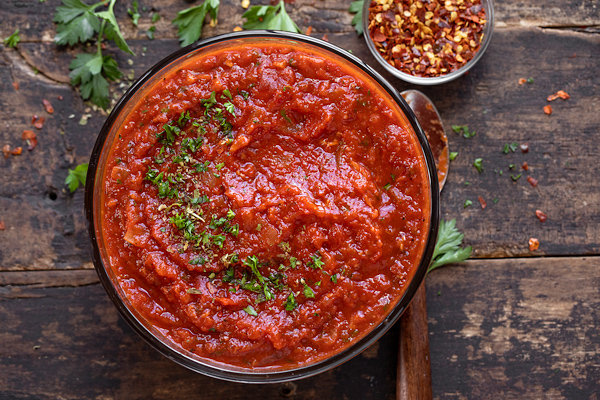
Tomato sauce is not confined to Italian cuisine. Here’s how different cultures make their own unique versions.
Italian
Italian tomato sauce (sugo or marinara) often includes olive oil, garlic, onions, and fresh herbs like basil and oregano. Variations may include meat (ragù), seafood, or vegetables.
French
In French cuisine, a basic tomato sauce (sauce tomate) includes a roux (butter and flour mixture), pork, carrots, onions, and a bouquet garni (bundle of herbs).
Spanish
Spanish tomato sauce (sofrito) typically includes tomatoes, onions, garlic, peppers, and sometimes smoked paprika for a deeper flavor.
Indian
In Indian cooking, tomato-based sauces often feature spices such as cumin, coriander, turmeric, and garam masala, creating a richly spiced, aromatic sauce.
Mexican
Mexican tomato sauce (salsa roja) may include tomatoes, onions, garlic, and chili peppers, with cilantro and lime added for freshness.
Personalizing Your Sauce
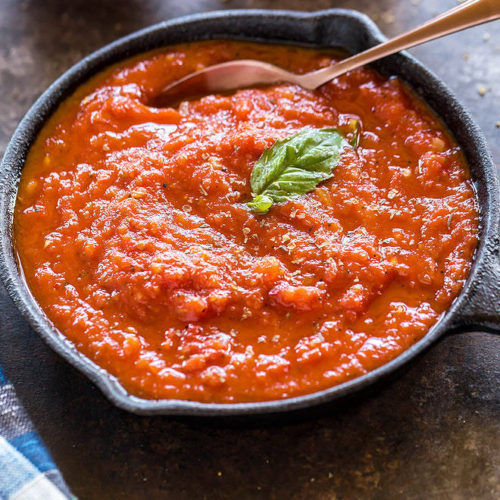
Tomato sauce can be incredibly personal and adaptable. Here are some tips to make it your own:
- Experiment with Herbs and Spices: Try different combinations of fresh and dried herbs to find your favorite blend.
- Adjust Sweetness and Acidity: Tweak the levels of sugar and acid to match your personal taste.
- Incorporate Different Proteins: Add various meats or keep it vegetarian with plant-based proteins like lentils or chickpeas.
- Play with Texture: Blend your sauce to a smooth consistency, leave it chunky, or find a happy medium.
- Try New Additions: Roasted vegetables, olives, capers, or a splash of cream can add unique twists to your sauce.
Conclusion
Making a great tomato sauce is both an art and a science, requiring attention to detail and a willingness to experiment. By selecting quality ingredients, balancing flavors, and mastering various techniques, you can create a tomato sauce that is rich, flavorful, and perfectly suited to your dishes. Whether you prefer a light, chunky sauce or a thick, velvety one, these tips and recipes will help you elevate your tomato sauce game and impress your family and friends.
Feel free to share your own tomato sauce tips and recipes in the comments below. Happy cooking!

